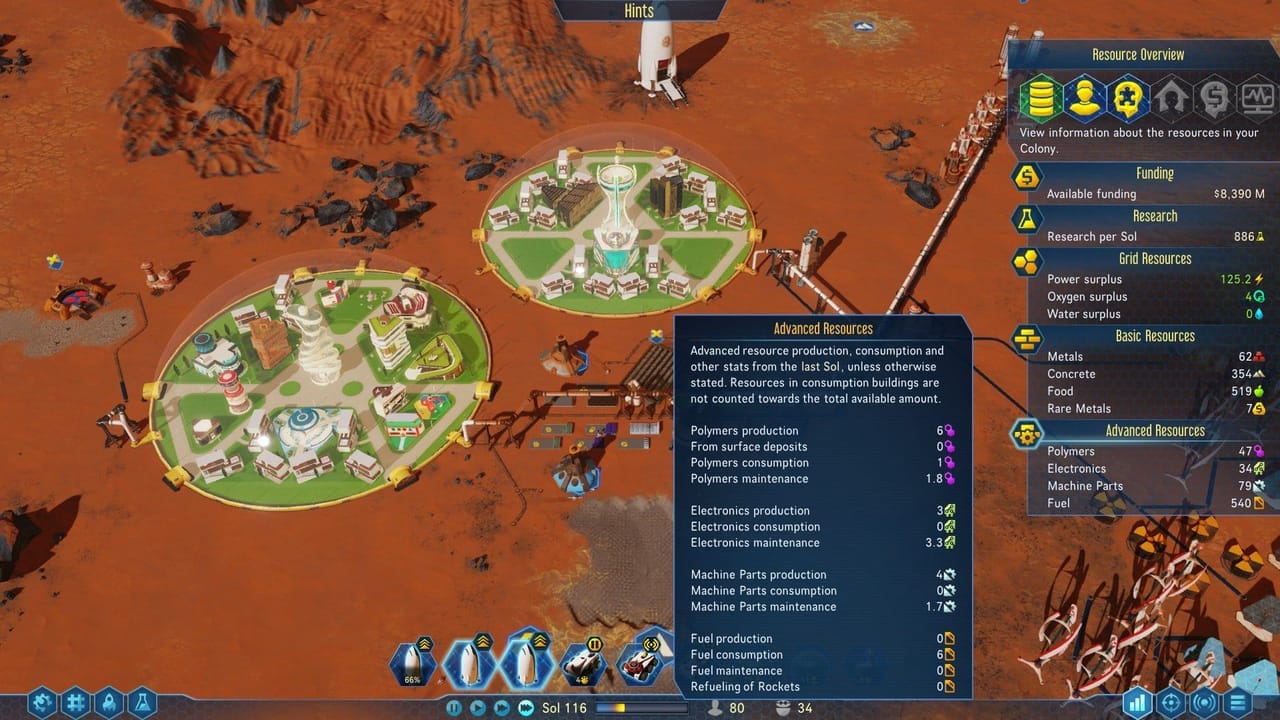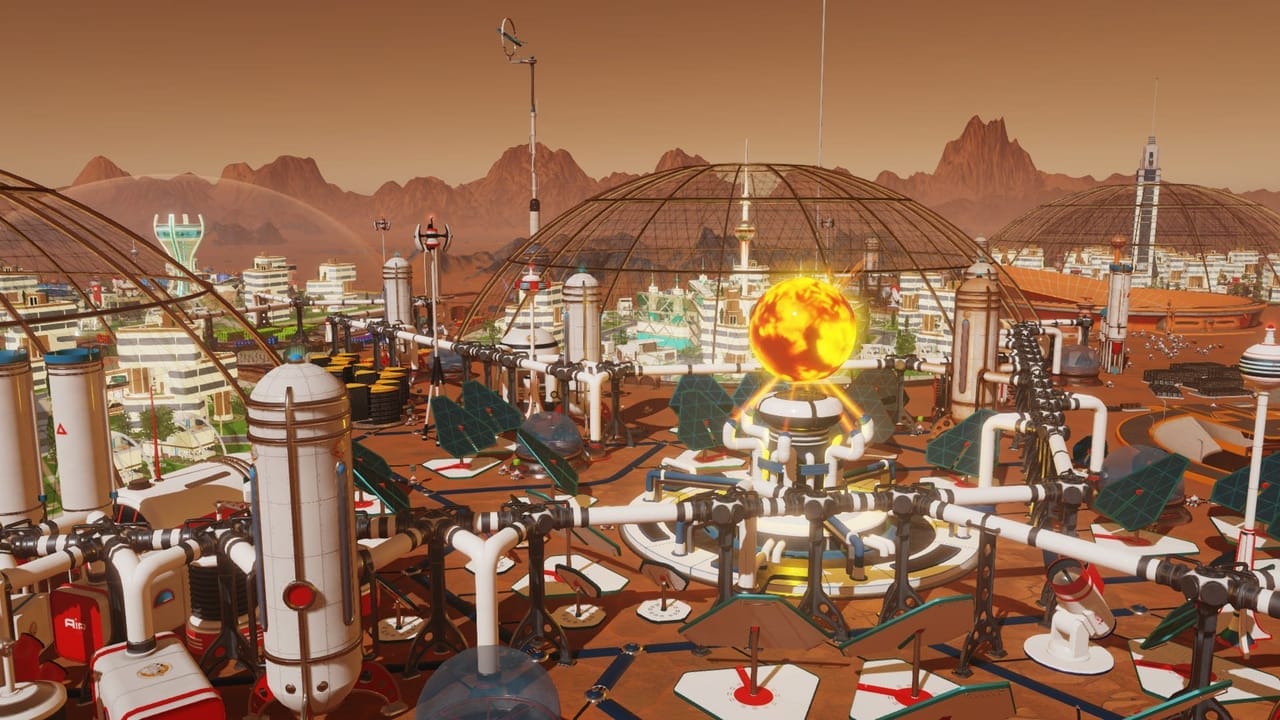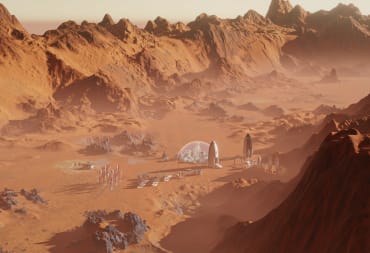I like games that let me build stuff and I like sci-fi. Mash both of those together and you'll immediately capture my attention (and probably an uncomfortable amount of my time - goodness knows how many hours I've spent in games like Planetbase.) Surviving Mars (developed by Haemimont Games and published by Paradox Interactive) is one such mixture of sci-fi city building that I was eager to seek my teeth into.
In Surviving Mars, you're tasked with setting up a colony on the titular red planet. You'll begin by choosing from a list of Sponsors for your mission. Each Sponsor has their own unique strengths, and some of the more difficult ones can have hefty downsides. You must also select a Commander Profile, which will typically unlock one of the game's technologies for free and give you a unique ability. For example, let's say you start the game with the "Hydro Engineer" Commander Profile. This will let you begin the game with a water deposit revealed on the map, the Water Reclamation technology already unlocked, and 25% lower water consumption in your domes. Once you've chosen your Sponsor and Commander Profile, you move on to outfitting your first rocket.
There are no freebies in Surviving Mars. You'll be paying for absolutely everything for your initial journey, and the money you spend now will mean that you'll have less available later. Cargo space is limited, so you'll want to not waste any space (or money!) bringing along prefabricated buildings or resources that you won't need for the first few Sols of your excursion.

Next, you'll select where to touchdown. A number of pre-selected landing sites are marked on the map, but you can also manually pick one on the planet using your mouse or a coordinates system. I'm personally quite fond of 14 N, 43 W. Each area has different levels of resources like Metal, Water, and Concrete. You'll also have to weigh the risks of Meteors, Dust Devils, Dust Storms, and Cold Waves. Each of these hazards will require you to adapt your colony's infrastructure just to keep things running (nevermind surviving in an extreme crisis).
Lastly, you'll choose from among one of the game's nine Mysteries. Each Mystery is a sort of random quest taken from the pages of sci-fi history. Whether you choose a specific Mystery or decide to select one at random, they'll likely add some unique technology or challenges that you might not expect to deal with. Once you've got all of these selections made, it's time to launch your first rocket towards the red planet.
The map in Surviving Mars is divided into a grid. You'll typically have one sector pre-scanned as a freebie and this usually makes for the best landing site. Once you touch down, your rovers and drones will unload from the rocket and the game begins proper. The first few Sols are a mix of setting up power generation, gathering resources, and beginning initial scans. It's tempting to build a colony as fast as possible, but I've found it's best to scan a good portion of the map, gather up resources, and select an ideal site so as to best maximize your chances of succeeding. Your initial base can operate with nary a human in sight for some time. While I've never attempted it, it's probably quite feasible to create a completely robotic base and never have a single human set foot on the planet.
Once you've got your first Dome ready to go (along with a secure supply of water and oxygen), it's time to select your first group of Colonists to move over to Mars. You can filter them by a number of positive and negative traits, age groups, or even gender. The latter part is especially important as procreation is very much a thing in Surviving Mars and it may be unwise to have the potential for making babies when your colony is still in its infancy.

With some luck (and a few hours of careful planning), you'll be able to start growing your operation by bringing in more colonists, adding more domes, and expanding your capabilities for exploiting Mars' mineral wealth. An evaluation looms over your head at the Sol 100 mark, although this only counts for a score and some in-game achievements. It's entirely possible to completely fail this evaluation with a score of 0 and continue playing. Once your evaluation is over, the game's Mystery will kick in.
Mysteries are a bit of a mixed bag. I personally believe they're the most interesting if you go in blind - they're sure to add unexpected challenges and shoot your plans to hell. You may be in an area with a very low risk of Meteors only to have the Mystery trigger a storm that lasts for several days. Most of the Mysteries will have you dealing with some sort of strange sci-fi phenomenon that will have a tangible effect on your colony and its population. There isn't a defined "solution" for many of them, either - you'll be able to decide what you think is the best course of action. Some of the Mysteries will unlock unique buildings or Research that you wouldn't otherwise see as part of the stock game.
Speaking of Research, one of the core parts of Surviving Mars is unlocking new technologies. Your Sponsor provides a small amount of daily Research towards this effort. You can further increase this amount with in-game buildings, researching technologies, or simply outsourcing it for a pile of cash. The end of most of the game's five Research trees typically has one or two powerful technologies, many of which unlock unique "Wonder" buildings that will provide some kind of useful service to your colony. For example, the Mohole Mine is an inexhaustible supply of Metal and Rare Metals that can easily support a colony of over a thousand people on its own.

Another randomized, unique element is Breakthroughs. These are special technologies that are discovered by having a certain type of RC Rover analyze an Anomaly you've uncovered on the map. Breakthroughs change with every game and vary greatly in their purpose. Some will simply buff existing equipment once researched, and a handful will grant you access to unique buildings like the Cloning Vat spire. Arguably, the most interesting ones are those which give you a totally unique piece of technology like Biorobots (androids that eat & sleep but never age and don't reproduce sexually) or change the dynamics of a game like converting your surplus Power generation into Research.
I worked my way through six of the game's Mysteries in around 100 hours. At least 20 of those hours was spent just figuring out what the heck I was doing in Surviving Mars. Once I understood the system and was able to build a somewhat stable colony, I was well-prepared to tackle the Mysteries that the game threw at me. I enjoyed the lot of them, although I found myself quite annoyed at the lack of a progress bar and the occasional bug in my pre-release build. I'm relatively certain that at least one of them bugged out on me and I never managed to reach its conclusion. I was also not terribly fond of the "Mystery Log" remaining on screen long after I had completed it and I wish I could have just made it disappear after I had beaten the challenges set before me.
It's difficult to decide what counts as "completing" a game of this style. After all, Surviving Mars is a city builder and those arguably end only when you've gotten bored with the whole affair. I've made colonies of all different sizes and I think it's quite possible to get up to thousands of colonists - perhaps even tens of thousands - with careful management and planning. However, it is here where the game's flaws began to pop up for me.

One of the most difficult problems I dealt with was the simple issue of people making too many damn kids. I could ship in two billion dollars worth of high-tech Polymers direct from Earth, but contraceptives were a nonexistent option. You're able to set the Domes to filter people in or out based on age, biological sex, and other factors and it's quite possible to control your population growth this way. I found it to be far too much micromanagement for my taste and would have greatly appreciated the ability to stem the neverending tide of children being born in some of my colonies (or at least the ability to ship people back to Earth!). I experimented with single-gender colonies and found the most success with a purely Biorobot colony where procreation is a non-issue. I'm admittedly quite bad at handling things like population growth in games such as these, but I nonetheless feel like this system could have offered better options for the player.
Aside from the occasional bugs and the dozens of children I hadn't expected, I found that Surviving Mars often lacked specificity in the strangest places. The Artificial Sun Wonder states that it uses a "massive amount of water on startup" in its Research tile. It would have been nice to know exactly how much that was (1,000 Water, if you're interested) so I could ensure that I had the necessary infrastructure in place.
Information is key in a game like this, and I was surprised to see a complete and total lack of long-term charts for resource production or population. The game provides you with daily stats on production, consumption, and maintenance, but even these seemed to be terribly off in many cases. I would have an on-paper surplus of one particular resource in terms of my production only to watch the supply gradually dwindle with no explanation other than the numbers I was being provided were way off.

Managing other aspects of your colony is also hampered by the interface. Moving drones to a new controller is a tedious task that must be undertaken one at a time since there's no option to band-box or otherwise select multiple units. Ordering supplies or producing certain objects is done by ticking a counter upwards a few units at a time. There doesn't seem to be a way to hold a modifier key and undertake actions in batches. This is especially frustrating in late-game colonies where you rely on constant imports in scenarios such as building a new dome or dealing with a production shortfall. Even though there were a handful of bugs throughout my time with Surviving Mars, the biggest issues I found were fundamentally baked into the game. I think this is an area that could be improved upon with later patches. As it stands right now, you can expect to deal with some annoying or frustrating bits that rightly could have been dealt with through small design improvements or more accurate information.
Graphically, Surviving Mars has a lovely retro sci-fi aesthetic. The trailers we've been treated to in the lead-up are definitely in the feel of this style of sci-fi, although the game itself doesn't quite capture that feeling outside of its architecture and Mysteries. The models of individual colonists are nicely detailed, and you can even see them working and living inside of the buildings placed within your domes.
As far as the sound goes, the game does a good job of keeping things interesting. There wasn't anything particularly outstanding or appalling in terms of the sound effects. I don't believe that any special accommodations were made for how things might sound different in the Martian atmosphere, but I'd wager that was a deliberate design choice rather than a lack of ability on the part of the developers. The game's music (delivered through one of four in-game radio stations) is catchy and covers different flavors including club music, country, and throwbacks to 1950's surfing culture. Three of the stations have DJs with their own unique personalities that will chime in between songs and add a little more to the overall experience.
When I first got my hands on Surviving Mars, I felt a bit of a sinking feeling in my stomach. There was a lot to figure out, and I was genuinely questioning if I would be able to wrap my head around the game. It felt great once I got the hang of it, and I think anyone who enjoys city builder games will find something to love in Surviving Mars. That said, it does have its fair share of flaws and I can't help but wonder how much of my frustration could have been avoided with a little more in the way of options and information.
Our Surviving Mars review was conducted on PC via Steam with a code provided by the developers. It is also available on Xbox One and PlayStation 4.
Review Summary
Surviving Mars is a solid city-builder, but some areas of the game require too much micromanagement and some critical information is either inaccurate or not presented in a useful way.
(Review Policy)Pros
- Compelling Mysteries Add Flavor To The Core Game
- Randomized Technology Makes Every Playthrough Different
- Plenty Of Space To Build & Grow Your Colony
Cons
- Inaccurate Or Missing Information In Many Places
- Too Much Micromanagement In Some Areas
Have a tip, or want to point out something we missed? Leave a Comment or e-mail us at tips@techraptor.net












